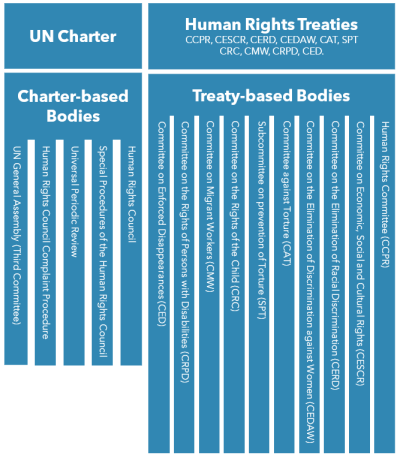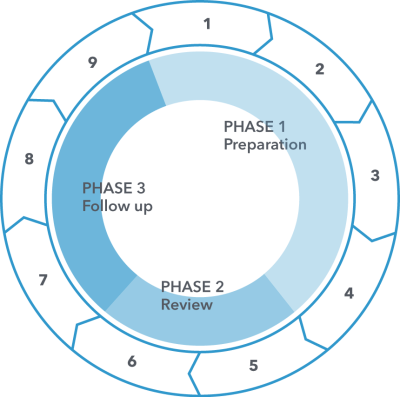
Reporting for national human rights institutions
Reporting on the national situation of human rights is a key output of monitoring by a national human rights institution.
National human rights institutions (NHRIs) can prepare reports aimed at the parliament, the government, the regional mechanisms, the international mechanisms as well as to civil society.
On this page, you will mainly find information about international reporting, but some of the recommendations on, for example, how to write a report, can also be useful for national (or regional) reporting.
Evidence-based and independent reporting is the first step towards taking action and improving the human rights situation.
National reporting can be a powerful tool to create awareness and knowledge about the human rights situation amongst the parliament, the government and civil society. Regional and international reporting is a way of drawing attention to national human rights concerns across the national borders. This can, for example, lead to an increased pressure on the state to change the situation.
The reports of the NHRIs to the international mechanisms have several names: they are known as stakeholder reports, parallel reports or shadow reports. As the names indicate, the reports are not state reports, but have independent views on human rights issues in their state.
On this page you can learn more about the reports of NHRIs and the UN human rights reporting system.
1. NHRIs' reporting
NHRIs reports must be independent and evidence-based. They should be short, concise and they should have recommendations that are specific and measurable.
Themes for a report
The report ought to mirror the NHRI's identified and prioritised human rights issues.
The content of the report can come from three sources:
- Recycle documentation: the report is based on knowledge that is already in-house such as data collected and analysed, legal briefs etc. which is a part of monitoring.
- Additional documentation: a study, analysis or similar can be initiated if the NHRI identifies a gap and has the needed resources.
- Other sources: the NHRI's own sources can be complemented by reliable and independent other sources.
Structure of a report
When doing international reporting, the format is sometimes given by the relevant body. However, this is not always the case. The below is inspiration for how a report can be structured whether it is for national, regional or international reporting (if there is not already a given format).
- Heading and short introduction to the NHRI
- Chapter 1: Structural issues
- Chapter 2: General provisions
- Chapter 3: Subjective rights/substantive rights
It is important to make clear references in foot- or end notes in order to substantiate the analysis of the NHRI. You can see more details and examples of the different elements of a report in the PDF below.

Recommendations
The main goal of an NHRI is to create positive human rights changes, in other words, initiate some actions that will lead to accomplishing this goal. That is why the recommendations are what reporting is eventually all about, and the reason any human rights monitoring or reporting should have recommendations.
SMART recommendations
As the recommendations should lead to action, they have to be precise and action-oriented. They need to be:
- Specific
- Measurable
- Attainable
- Realistic
- Timely
Which is often referred to as SMART.
An example of a recommendation which is SMART, could be: "Re-issue an invitation to the UN Special Rapporteur on Torture".
An example of a recommendation which is not, could be: "Preserve the national process of appeasement and reconciliation".
Which of the two would be the easiest to measure progress on?
5 categories of recommendations
Recommendations should entail action. However, they can be more or less action-oriented. Recommendations are divided into five categories ranging from 1 (weak) to 5 (strong).
- Category 1: A recommendation directed at Recommending States, or calling upon the State under Review (SuR) to request technical assistance, or share information
> Example of verbs used: call on, seek, share - Category 2: A recommendation emphasising continuity
> Example of verbs used: continue, maintain, persevere, persist, pursue - Category 3: A recommendation to consider change
> Example of verbs used: analyse, consider, envisage, envision, examine, explore, reflect upon, revise, review, study - Category 4: A recommendation of action that contains a general element
> Example of verbs used: accelerate, address, encourage, engage with, ensure, guarantee, intensify, promote, speed up, strengthen, take action, take measures or steps towards - Category 5: A recommendation of specific action
> Example of verbs used: conduct, develop, eliminate, establish, investigate, undertake; as well as legal verbs: abolish, accede, adopt, amend, implement, enforce, ratify
So the more concrete and action-oriented the action, the higher the category.
2. The UN human rights reporting system
The two main UN mechanisms in international human rights reporting are the the UN Charter-based bodies and the UN Treaty-based bodies.

In the PDF below, you can find an overview of the bodies and links to their websites.
UN Treaty-based bodies
NHRIs only report to the treaties that are legally binding, and that the state has obligated itself to respect, implement and fulfill. The state engages itself through either ratification, acceptance, accession or succession of the treaty. However, it is only the ratification of a treaty that makes treaties legally binding for the state.
The treaty body is a committee of elected independent experts that monitors how the concerned treaty is protected and implemented by the states that have ratified the treaty. So the recommendations are based on expert assessments and observations.
Each treaty body has its own rules of procedure, working methods, general comments or established practices.
NHRIs should, therefore, familiarise themselves with the treaty body reporting guidelines, such as deadlines, process formats etc., on the websites of the individual treaty bodies. However, there are some typical reporting steps, which you can learn more about in the PDF below.

UN Charter-based bodies and the UPR
The UN Charter-based bodies are unique in that the bodies involve all of the UN member states. However, unlike the UN treaty bodies, the UN Charter-based bodies cover all UN human rights standards, and their monitoring activities are not limited to specific UN human rights treaties.
This means that the UN Charter-based bodies are the ones that most states report to, and are engaged with.
It is, therefore, important for NHRIs to know how to engage with these bodies, especially the Universal Periodic Review (UPR). The UPR covers all UN human rights conventions a given state has ratified, which is why it is sometimes referred to as a ‘health check’ of the human rights situation in a country.
The recommendations to the state under review are presented by other states. They are sometimes general and statements of intentions. Other recommendations are precise and point to specific actions to be taken.
UPR holds the strength that the states commit themselves by voluntarily adopting the recommendations they wish to adopt and this political commitment is unique. NHRIs are encouraged to report to and participate in the UPR.
The UPR cycle has three phases and nine steps which you can learn more about in the PDF below.

PLEASE NOTE: The content on this page is an extract of an e-learning module on reporting. In the e-learning module you can find a lot more details, examples and exercises. Go to e-learning course
